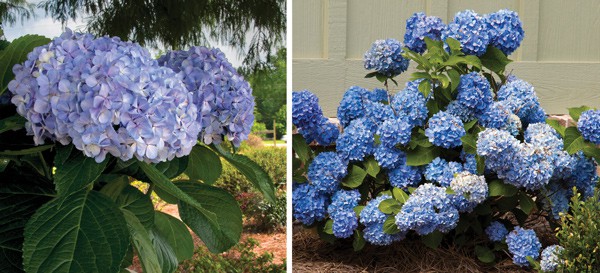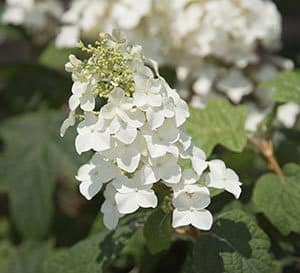By Kimberly Toscano
Hydrangeas are among the most nostalgic of garden plants, stirring memories of grandmother’s garden and the endless summers of youth. And with their lush foliage and long-lasting blooms, few plants are as deserving of a place in the garden.
While we tend to lump all hydrangeas together, the group represents several distinct species, each with a unique set of growing requirements. Understanding how to use and care for each type of hydrangea will ensure these beauties endure to deliver a lifetime of new garden memories.
Old Wood Versus New Wood
Some hydrangea species bloom on last-year’s growth, which is often called “old wood.” This old wood contains the flower buds that will open with the coming summer. Pruning in winter or spring would remove the flower buds, leaving us with a bloomless plant this year. Therefore, these varieties are pruned after blooming in summer.
Hydrangeas that bloom on new wood produce flower buds on the young growth that emerges in spring. Because the buds are not present during the winter months, these plants can be pruned in late winter or early spring, before new growth begins.

Bigleaf Hydrangeas: Hydrangea macrophylla
With handsome, glossy foliage and gorgeous ball-like blooms, bigleaf hydrangea is the Southern Belle of hydrangeas. This diverse group includes two main flower types, large mopheads like those of ‘Big Daddy’ and Dear Dolores™Hydrangea, and frilly lace-caps. The flowers of bigleaf hydrangeas shift from blue to pink, depending on soil pH, and make excellent cut flowers.
Ideal Conditions for Bigleaf Hydrangeas
Bigleaf hydrangeas grow best with morning sun and afternoon shade. Hardy to zone 5, they require a well-drained soil and plenty of water. Avoid hot, exposed sites. Plant as showy accents or specimens, or en masse for a stunning display. Bigleaf hydrangeas also perform well in containers.
Pruning Bigleaf Hydrangeas
Bigleaf hydrangeas bloom on old wood. Prune in the summer after plants finish blooming and strong new shoots have developed from the base of the plant. Remove weak shoots, both old ones and new ones, cutting them at the base. Leave several stems of old productive wood as well as strong new stems that will flower next season.

Panicle Hydrangeas: Hydrangea paniculata
Also known by the common name PeeGee, panicle hydrangeas are robust plants with excellent hardiness, and drought tolerance. They thrive in the hot and humid summers of the deep South and shrug off frigid northern winters. These are the easiest hydrangea to grow, but you wouldn’t know it from their over-sized blooms. Showstoppers like White Wedding® and Moon Dance™ Hydrangea give bigleaf varieties a run for their money.
Ideal Conditions for Panicle Hydrangeas
Panicle hydrangeas are hardy to zone 4 and tolerate a wide range of soils. Plants perform well in full sun to part shade, and bloom best with sun. Water well the first season to establish plants. Perfect for hedges and massing, as well as containers.
Pruning Panicle Hydrangeas
Panicle hydrangeas bloom on new wood and can be pruned in winter or early spring before new growth emerges. Pruning is not necessary, but can stimulate increased flower production. Panicle hydrangeas tolerate heavy pruning to maintain size and are sometimes shaped into a tree form.

Oakleaf Hydrangeas: Hydrangea quercifolia
This North American native shines all year long with large white to pink summer panicles, vibrant fall color, and exfoliating bark. Large oak-shaped leaves set this species apart from the others, as does its size. Growing 6- to 8-feet-tall and wide, oakleaf hydrangea has a commanding presence in the garden. Mass varieties like Tara™Hydrangea for big impact in shady beds.
Ideal Conditions for Oakleaf Hydrangeas
Stunning in woodland gardens and mixed borders, this species tolerates full sun to part shade in hardiness zones 5 through 9. Drought tolerant, but thrives in moist soils, give oakleaf hydrangea a well-draining location. Plants benefit from a layer of mulch year round.
Pruning Oakleaf Hydrangeas
Oakleaf hydrangeas require very little pruning. Plants flower on old wood, so pruning to shape the plant, if needed, should be done in summer after the plant finishes flowering. Dead or damaged branches can be removed any time.

Smooth Hydrangeas: Hydrangea arborescens
Native to the southern United States, smooth hydrangeas are easy to grow and very cold hardy. Often incorrectly referred to as Annabelle hydrangea, this species produces large, rounded flower heads in white, pink, and green hues.
Ideal Conditions for Smooth Hydrangeas
Smooth hydrangea requires a partly shaded location to thrive. Bright shade, or morning sun support blooming while protecting plants from hot afternoon sun. Plants are susceptible to drought and perform best with even moisture. A lovely addition to mixed borders and woodland gardens, or tucked behind perennials.
Pruning Smooth Hydrangeas
Smooth hydrangeas bloom on new wood. Plants are commonly cut back to the ground in late winter to early spring to encourage abundant blooms and maintain plants at a manageable size. If a larger shrub is desired, cut back some of the stems to the ground, leaving others at varying lengths, from 1- to 2-feet.
How Large Do Grow Hydrangeas Grow?
Now that you have learned more about the four types of hydrangeas, you may wonder how big hydrangeas get. Great question!
Hydrangeas from Southern Living Plants vary in size based on the type and species. For example:
-
‘Big Daddy’ Hydrangea macrophylla can reach 5-6 feet tall and wide and is known for its huge blooms in blue or pink depending on soil acidity. The much more compact Heart Throb® Hydrangea grows to only 3 feet tall and wide and offers unique dark red blooms edged with green that age to green with hints of red.
-
White Wedding® Hydrangea paniculata is bred to be more compact than most paniculatas and grows to about 4-6 feet, with a more compact, upright shape and white flowers.
-
Another Southern Living Hydrangea, Tara® Hydrangea quercifolia, offers dazzling, pillowy white blooms and colorful fall foliage, and grows to 6 feet tall and wide.
As you plan your landscape, there’s a hydrangea for every style and space. With a little care—like adjusting soil pH to fine-tune flower colors or pruning to maintain shape—these flowering shrubs will reward you with lush, season-long blooms. Now, it’s time to shop for your favorite Southern Living Hydrangea!












